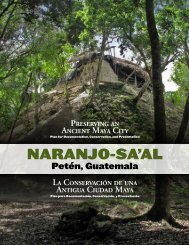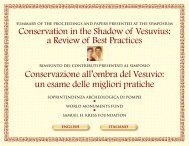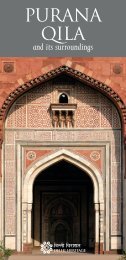2008 Annual Report - World Monuments Fund
2008 Annual Report - World Monuments Fund
2008 Annual Report - World Monuments Fund
Create successful ePaper yourself
Turn your PDF publications into a flip-book with our unique Google optimized e-Paper software.
The wealth of monumental religious and vernacular architecture of Africa and the Middle<br />
East is often eclipsed by conflict, a lack of modern infrastructure, poverty, hunger, and<br />
disease. Preservation programs must go beyond the physical restoration of sites to improve<br />
local economies and develop and maintain the traditional skills and crafts of this region’s<br />
cultures. Our programs here focus on building the capacities of local organizations and<br />
communities to preserve their heritage while creating opportunities for the future.<br />
Africa and the<br />
Middle East<br />
10<br />
Cairo, Egypt<br />
Watch 2006 (Tarabay al-Sharify)<br />
Tarabay al-Sharify<br />
and the Blue Mosque<br />
The creation of the Al Azhar Park in the heart of Cairo—a verdant<br />
open space reclaimed by the Aga Khan Trust for Culture (AKTC)<br />
from a vast garbage dump—has spurred development and enhanced<br />
community life in one of the world’s most populous cities. In tandem<br />
with the completion of this park, the <strong>World</strong> <strong>Monuments</strong> <strong>Fund</strong> has<br />
worked with AKTC for several years in the medieval Darb al-Ahmar district of<br />
historic Cairo to preserve some of the city’s most important religious buildings.<br />
The AKTC, in turn, focuses on neighborhood rehabilitation, health care,<br />
microcredit, and vocational training in the neighborhoods surrounding these<br />
monuments.<br />
This year, WMF support allowed the restoration of Tarabay al-Sharify, a<br />
handsome Mamluk building dating from 1503 that features high-quality stone<br />
carving, polychrome marble, and gypsum decoration. Work continued on the<br />
adjacent madrassa (Koranic school) and sabil kutab, a unique Islamic combination<br />
of a well, fountain, and elementary school that is the traditional gathering place for<br />
every neighborhood in historic Cairo.<br />
Simultanously, work began on the 17th-century Blue Mosque complex, celebrated<br />
for its blue Iznik tiles from Turkey, a rare example of Ottoman influence in<br />
Cairo. Each successful project completion calls attention to the enormous need<br />
to preserve and reuse the many neglected and unoccupied monuments of this<br />
culturally rich city. WMF’s collaboration with AKTC ensures conformity with the<br />
highest international conservation standards.
















